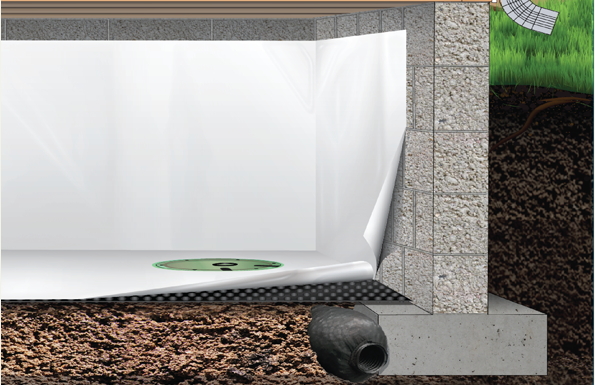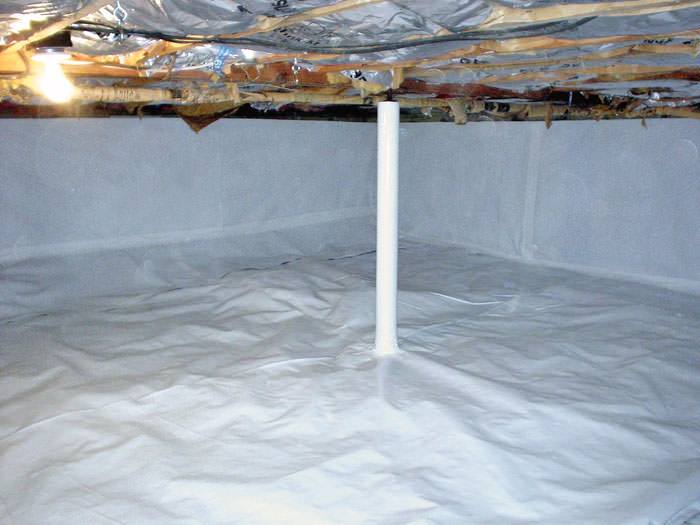Water problems are the bane of crawl spaces. Anything from flooding to overly high humidity can cause an array of problems that range from annoying to health hazards to structural issues. The solution to these is to have professional crawl space encapsulation done.
Crawl space encapsulation is a type of waterproofing for crawl spaces that will keep moisture problems from rearing their ugly head.
If your crawl space isn’t encapsulated, contact the crawl space experts at Tar Heel Foundation Solutions to schedule a crawl space inspection for your Charlotte-area home. Whether to stop current water problems or prevent the possibility of future ones, crawl space encapsulation is the waterproofing solution that you need.
Crawl space encapsulation is the process of fully covering your crawl space with sheeting called a vapor barrier along with taking other steps to seal off the crawl space from moisture.


Vapor barriers are made of puncture-resistant material that keeps out any water or moisture that might accumulate.
They are part of a successful crawl space waterproofing system. The vapor barrier prevents water from entering through the floors and walls of your crawl space, contributing to keeping it dry.
Read more about crawl space encapsulation as part of a home waterproofing plan.
Have you ever found yourself asking, “What is that smell” when you enter your home? Is it a musty, wet odor?
If so, check for moisture in and around your home’s foundation or crawl space.
Much like any other damp, dark space, a crawl space with moisture problems will develop a musty smell. And that smell does not stay in your crawl space. The air in the crawl space will seep through to the rest of your home, bringing the smell with it.
As problems go, it isn’t catastrophic. But it often isn’t pleasant, and it can be a harbinger of more serious problems.
{ “@context”: “http://schema.org”, “@type”: “LocalBusiness”, “name”: “Tar Heel Foundation Solutions”, “image”: [ “https://www.tarheelfoundationsolutions.com/wp-content/uploads/2017/01/Foundation-Products-Made-in-the-USA.-1.png”, “https://www.tarheelfoundationsolutions.com/wp-content/uploads/2016/05/contact-us-img.jpg”, “https://www.tarheelfoundationsolutions.com/wp-content/themes/tarheel/images/services-img.jpg” ], “telephone”: “803-246-5480”, “email”: “brandon@tarheelfs.com”, “url”: “https://www.tarheelfoundationsolutions.com/”, “areaServed”: [{ “@type”: “City”, “name”: “Charlotte”, “sameAs”: “https://en.wikipedia.org/wiki/Charlotte,_North_Carolina” }] }If you don’t go into your crawl space, you may not even know you have cracks, until the cracks cause a bigger problem.
Cracks in the walls and floors of your crawl space can allow moisture and pests into your home. It takes a crack no bigger than a hair to allow water in and some pests need less than a 1/8″ crack to invade your crawl space.
If you have cracks in your crawl space walls, even if you don’t see the evidence of water problems, the likelihood exists that excessive moisture will eventually infiltrate the space.
If your crawl space has excess moisture, the wooden portions of your home’s supports may succumb to wood rot.
Wood rot can weaken and damage your supports, leading to buckled or sinking floors, leaning walls, and doors or windows that don’t shut or open correctly.
Have you noticed that your floors suddenly feel spongy in some areas? This could be caused by a rotting floor joist in the crawl space.
Wood rot also attracts some insects, speeding up the destruction of the support beams.
There are many health issues related to mold in homes. They can range from runny noses and itchy eyes to, in rare cases, neurological damage and even death.
Children and older adults are usually more susceptible to mold and mildew reactions, but anyone can experience problems associated with the spores. They are especially prone to inflame any existing respiratory issues.
The majority of your home’s air comes from the crawl space, so if your crawl space attracts mold, the spores will reach the living area.
Public health officials endorse crawl space vapor barriers as a key step in protecting your family from the health hazards of mold.
In most cases, the problems show up during the spring and summer due to the increase in humidity.
Read more: Is It Worth It to Encapsulate Your Crawl Space?


By sealing your crawl space, you can benefit from:
It was long believed that the best way to vent your home was with outside air, but it has been proven that it causes more problems.
Recent studies now show that when the humid air comes into play with your vent system, it creates a bigger moisture problem.
Just because the most prevalent time for issues to arise is in the humid spring and summer, does not mean that the problems are not there year-round. Most of us think that when we have a moisture problem, then we must have a heating or air problem. This is not true, as the problem is poor ventilation in your home’s crawl space.
There are many benefits to sealing your crawl space. In fact, in North Carolina, the code for new construction mandates crawl space encapsulation. Crawl space encapsulation completely seals the area from the outside. According to the North Carolina Building Code, new construction needs to meet these guidelines:
Contractors are turning to a new method of waterproofing for your crawl space. It is a system that uses no outside vents and has a water drainage system and a ground vapor barrier or crawl space encapsulation. We can also repair any structural damage that moisture has already caused in your Charlotte-area home.